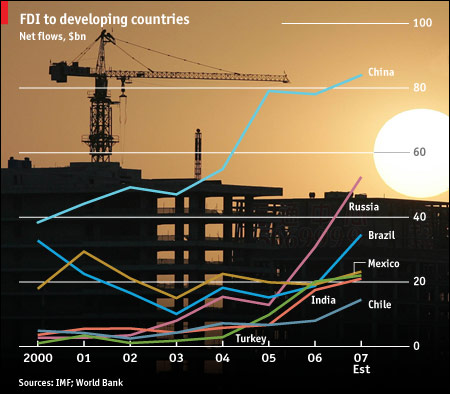Foreign Direct Investment (FDI)
Please note that we are not authorised to provide any investment advice. The content on this page is for information purposes only.
Foreign Direct Investment, or FDI, is a measure of foreign ownership of domestic productive assets such as factories, land and organizations. Foreign direct investments have become the major economic driver of globalization, accounting for over had of all cross-border investments.
Foreign Direct Investment, or FDI, is a measure of foreign ownership of domestic productive assets such as factories, land and organizations. Foreign direct investments have become the major economic driver of globalization, accounting for over had of all cross-border investments.
The most profound effect has been seen in in developing countries, where yearly foreign direct investment flows have increased from an average of less than $10 billion in the 1970s to a yearly average of less than $20 billion the 1980s. From 1998 to 1999 itself, FDI grew from $179 billion to $208 billion and now comprise a large portion of global FDI. According to UNCTAD, spurred on by mergers and acquisitions and the internationalization of production in a range of industries, inward FDI for developing countries rose from $481 billion in 1998 to $636 billion in 2006.
And China is at the forefront of FDI growth, followed by Russia, Brazil and Mexico.
Image: The Economist
FDIs do not only provide an foreign capital and funds, but also provides domestic countries with an exchange of skill sets, information and expertise, job opportunities and improved productivity levels.
The “Asian Tiger” economies such as China, South Korea, Singapore and the Philippines benefitted tremendously and experienced high levels of economic growth at the onset of foreign direct investment into their economies. Given the high growth rates and changes to global investment patterns, the definition to FDI has evolved to include foreign mergers and acquisitions, investments in joint ventures or strategic alliances with local enterprises.
[quote]With the advent and growth of the internet, many traditional cases of FDI which required huge amount of capital and physical investments are slowly becoming obsolete, especially for developed countries. The rise of small internet startups that require less research and development investment and the shift towards knowledge based economies, where the emphasis is placed on human capital rather than manual labour, has altered the playing field for FDIs. [/quote]Trends in Foreign Direct Investment (FDI)
Historically, FDI has been directed at developing nations as firms from advanced economies invested in other markets, with the US capturing most of the FDI inflows. While developed countries still account for the largest share of FDI inflows, data shows that the stock and flow of FDI has increased and is moving towards developing nations, especially in the emerging economies around the world.
Aside from using FDIs as investment channel and a method to reduce operating costs, many companies and organizations are now looking at FDI was a way to internationalize. FDIs allow companies to avoid governmental pressure on local production and cope with protectionist measures by circumventing trade barriers. The move into local markets also ensures that companies are closer to their consumer market, especially if companies set up locally-based (national) sales offices.





